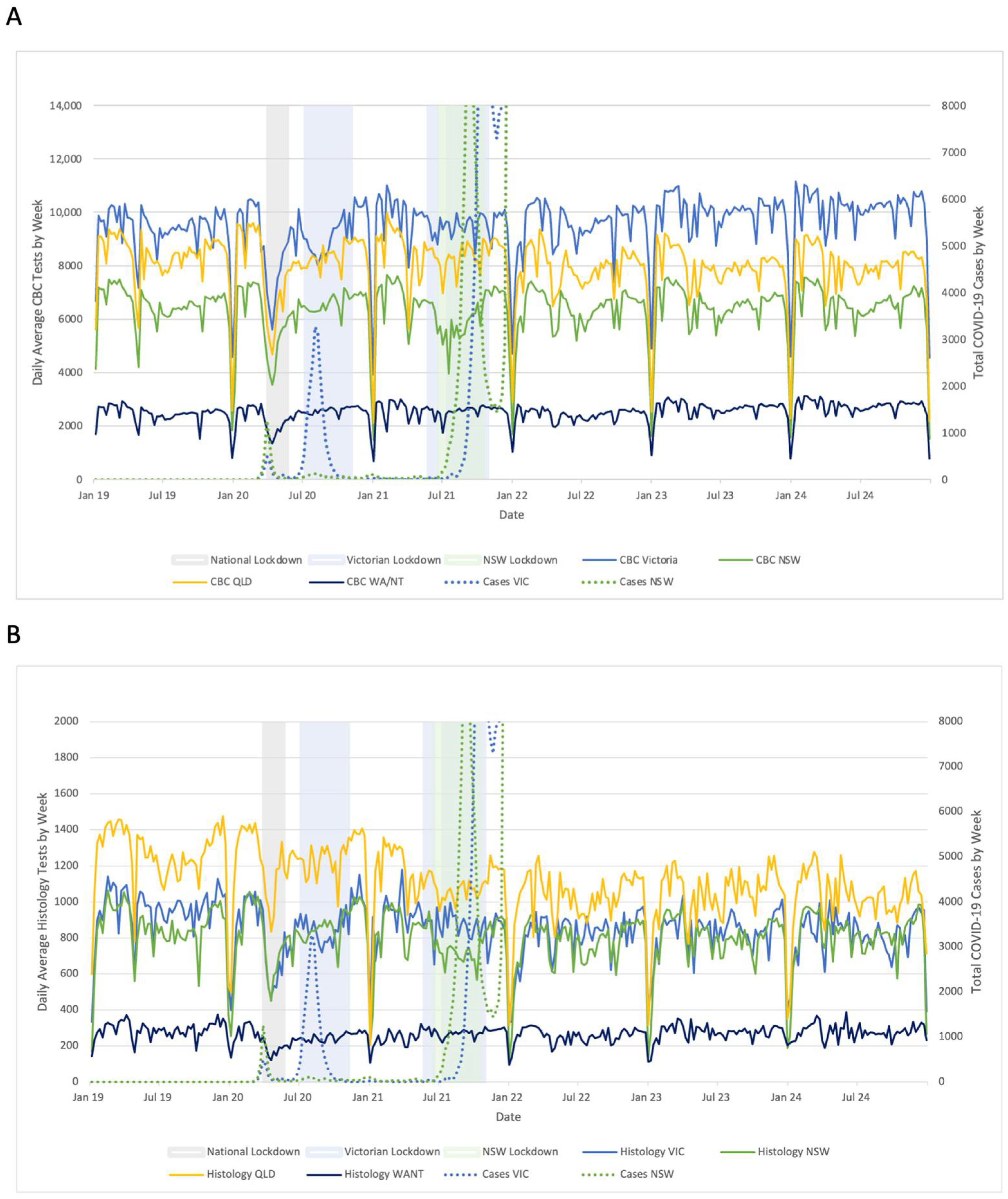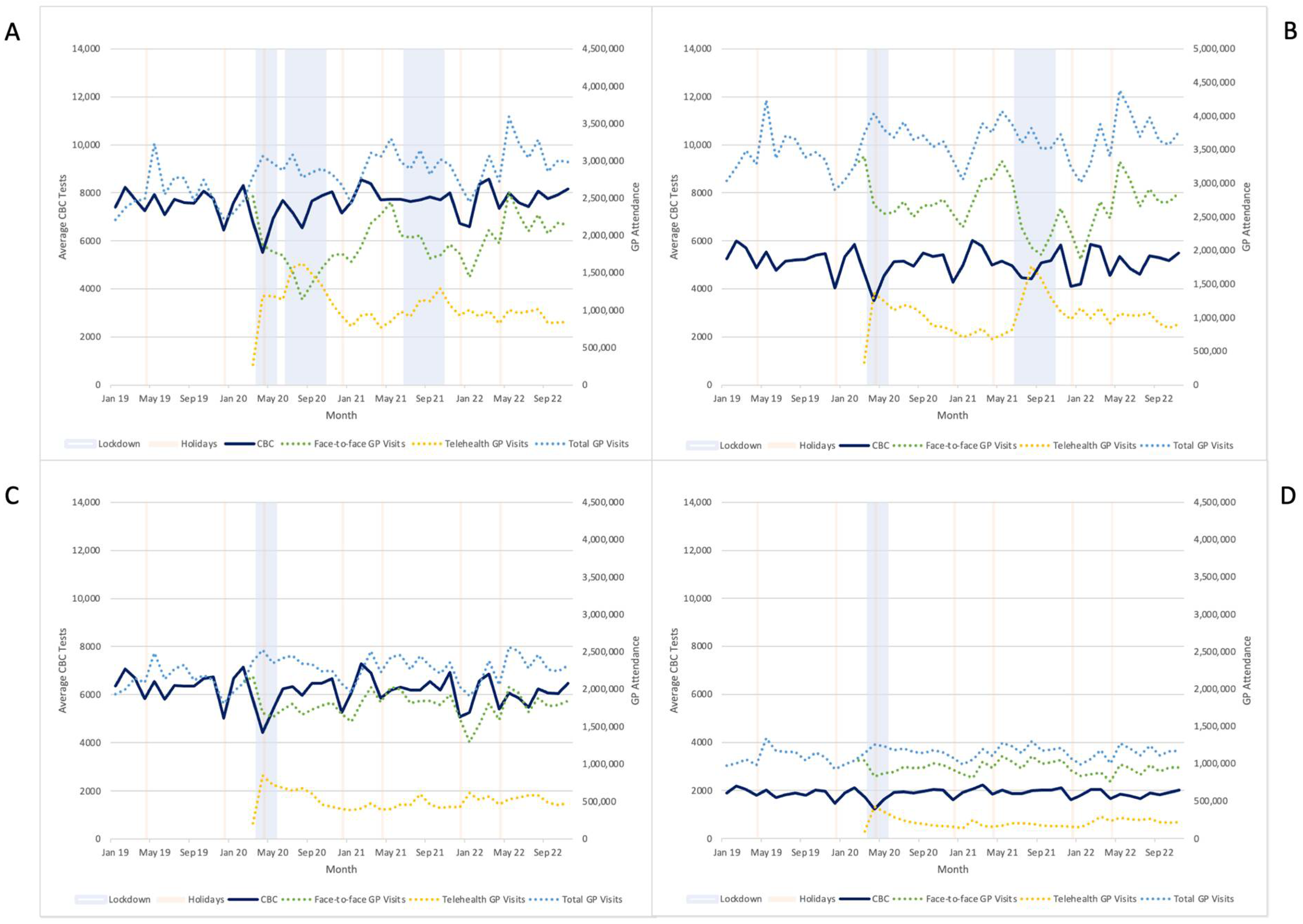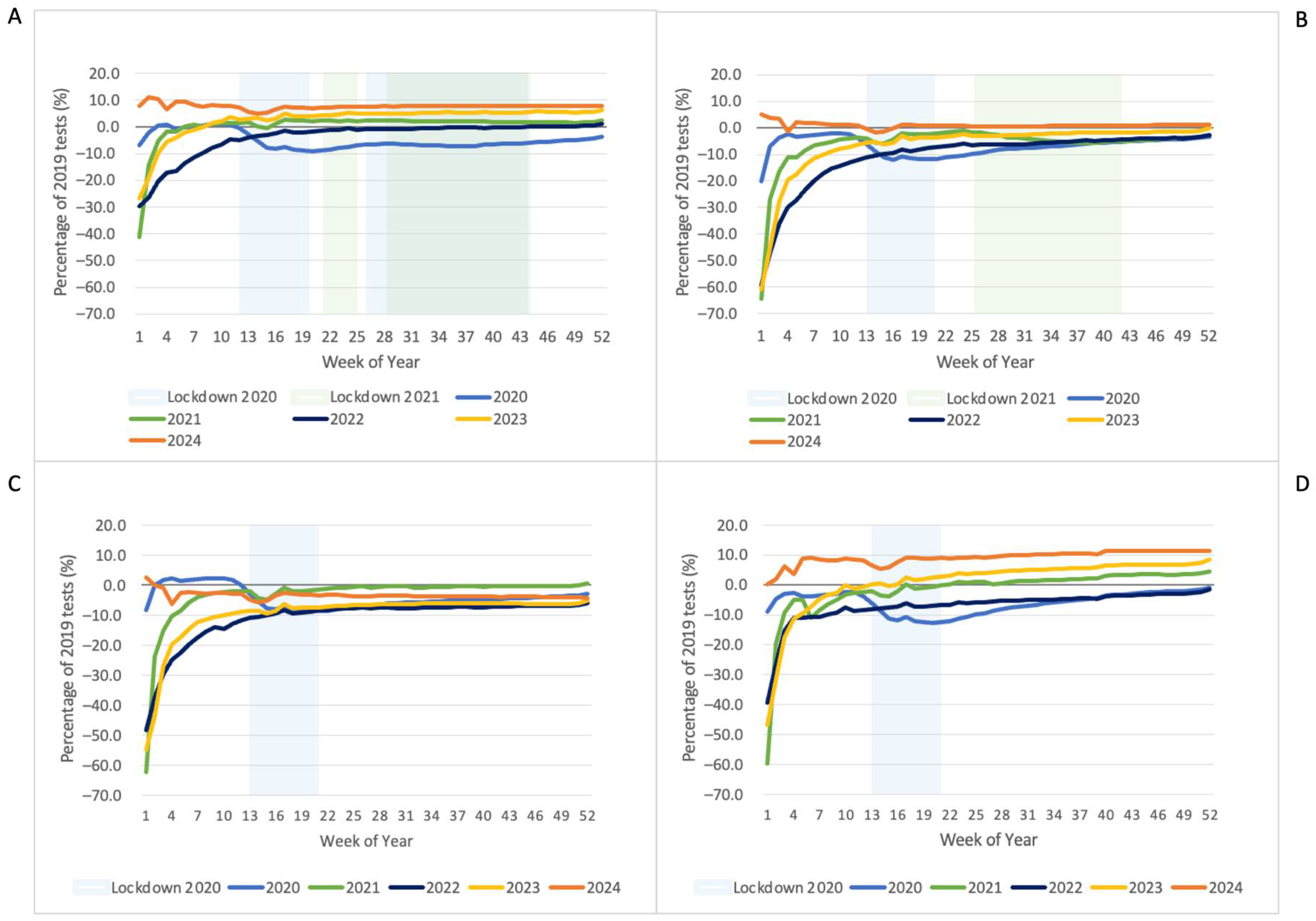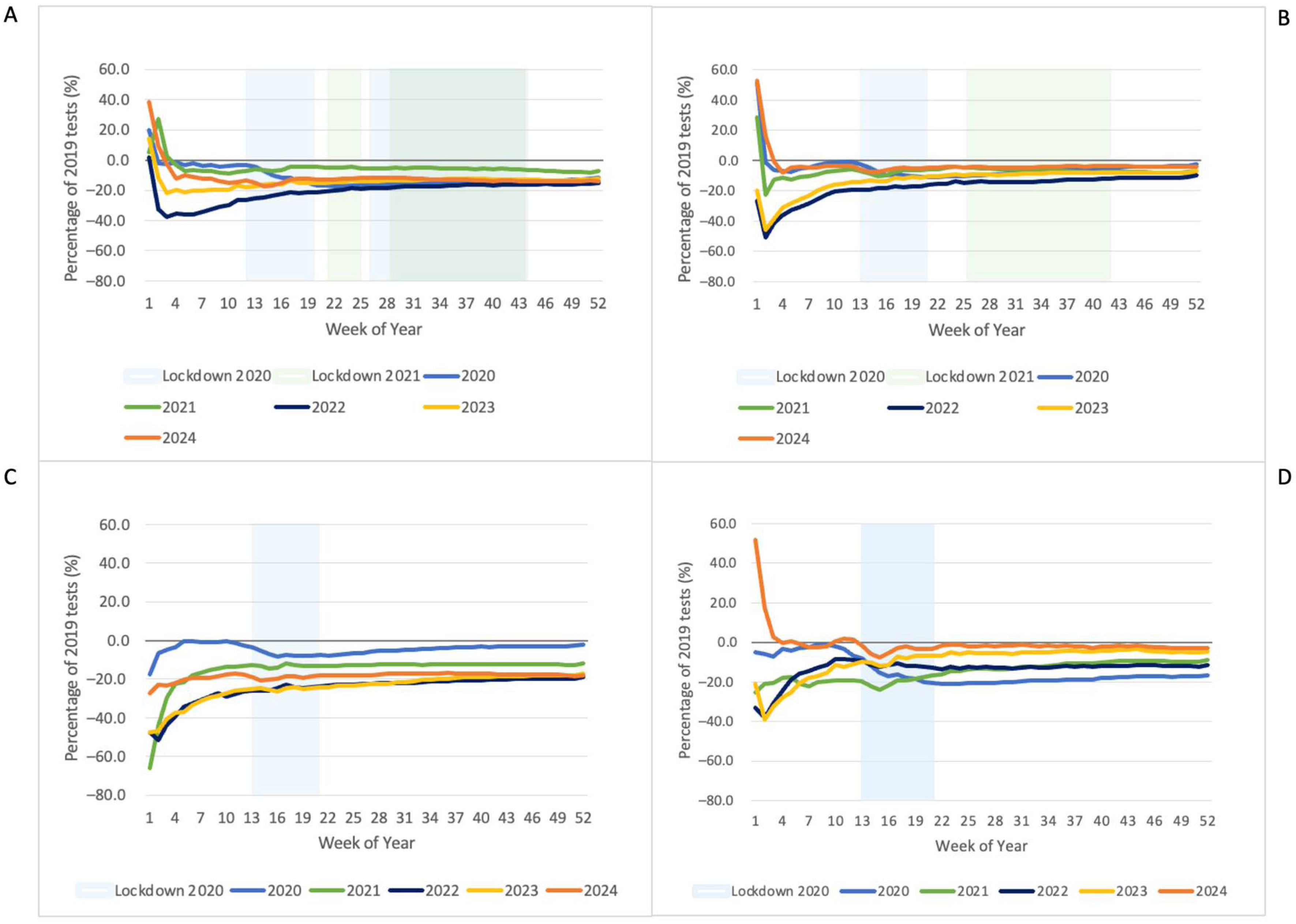Pandemic Disruptions to Private Pathology Testing Uptake in Australia, 2019–2024
Abstract
1. Introduction
2. Materials and Methods
2.1. Data
2.2. Data Analysis
3. Results
3.1. Daily Average Tests
3.2. GP Consultations
3.3. Cumulative Testing Numbers
4. Discussion
5. Conclusions
Author Contributions
Funding
Institutional Review Board Statement
Informed Consent Statement
Data Availability Statement
Acknowledgments
Conflicts of Interest
Abbreviations
| COVID-19 | SARS-CoV-2 coronavirus |
| CBC | complete blood count |
| GP | General Practice |
| HbA1c | haemoglobin A1c |
| HIV | human immunodeficiency virus |
| HPV | gynaecological cytology |
| MBS | Medicare Benefits Schedule |
| NSW | New South Wales (state) |
| PSA | prostate specific antigen |
| Qld | Queensland (state) |
| Vic | Victoria (state) |
| US | United States of America |
| WA/NT | Western Australia (state) and the Northern Territory |
References
- Centre for International Economics. The Economic Value of Pathology: Achieving Better Health, and a Better Use of Health Resources; Centre for International Economics: Canberra, Australia, 2019; p. 34. Available online: https://www.thecie.com.au/publications-archive/the-economic-value-of-pathology-achieving-better-health-and-a-better-use-of-health-resources (accessed on 25 June 2025).
- Hanna, T.P.; King, W.D.; Thibodeau, S.; Jalink, M.; Paulin, G.A.; Harvey-Jones, E.; O’Sullivan, E.; Booth, C.M.; Sullivan, R.; Aggarwal, A. Mortality due to cancer treatment delay: Systematic review and meta-analysis. BMJ 2020, 371, m4087. [Google Scholar] [CrossRef] [PubMed]
- Imai, C.; Li, L.; Hardie, R.A.; Georgiou, A. Adherence to guideline-recommended HbA1c testing frequency and better outcomes in patients with type 2 diabetes: A 5-year retrospective cohort study in Australian general practice. BMJ Qual. Saf. 2021, 30, 706–714. [Google Scholar] [CrossRef] [PubMed]
- Vigliar, E.; Cepurnaite, R.; Acaraz-Mateos, E.; Ali, S.; Baloch, Z.; Bellevicing, C. Global impact of the COVID-19 pandemic on cytopathology practice: Results from an international survey of laboratories in 23 countries. Cancer Cytopathol. 2020, 128, 885–894. [Google Scholar] [CrossRef] [PubMed]
- van Velthuysen, M.L.F.; van Eeden, S.; le Cessie, S.; de Boer, M.; van Boven, H.; Koomen, B.M.; Roozekrans, F.; Bart, J.; Timens, W.; Voorham, Q.J.M. Impact of COVID-19 pandemic on diagnostic pathology in the Netherlands. BMC Health Serv. Res. 2022, 22, 166. [Google Scholar] [CrossRef] [PubMed]
- Singh, I.R.; Dowlin, M.; Chong, T.H.; Nakamoto, J.M.; Hilborne, L.H. Changes in Test Volumes During Coronavirus Disease 2019 (COVID-19): A Laboratory Stewardship Opportunity. Arch Pathol. Lab. Med. 2021, 145, 821–824. [Google Scholar] [CrossRef] [PubMed]
- Commonwealth Government Australia. COVID-19 Response Inquiry. 2024. Available online: https://www.pmc.gov.au/sites/default/files/resource/download/covid-19-response-inquiry-report.pdf (accessed on 25 June 2025).
- Imlach, F.; McKinlay, E.; Kennedy, J.; Pledger, M.; Middleton, L.; Cumming, J.; McBride-Henry, K. Seeking Healthcare During Lockdown: Challenges, Opportunities and Lessons for the Future. Int. J. Health Policy Manag. 2022, 11, 1316–1324. [Google Scholar] [CrossRef] [PubMed]
- Moore, R.; Purvis, R.S.; Hallgren, E.; Reece, S.; Padilla-Ramos, A.; Gurel-Headley, M.; Hall, S.; McElfish, P.A. “I am hesitant to visit the doctor unless absolutely necessary”: A qualitative study of delayed care, avoidance of care, and telehealth experiences during the COVID-19 pandemic. Medicine 2022, 101, e29439. [Google Scholar] [CrossRef] [PubMed]
- Gillam, M.H.; Roughead, E.; Tavella, R.; Dodd, T.; Beltrame, J.; Ryan, R. The impact of COVID-19 restrictions on pathology service utilisation. Intern. Med. J. 2021, 52, 42–48. [Google Scholar] [CrossRef] [PubMed]
- Deam, D.; Nazaretian, S. The True Impact of Australia’s COVID-19 Lockdowns on Critical Health Diagnoses. 2025. Available online: https://www.clinicallabs.com.au/about-us/doctor-media-releases/the-true-impact-of-australia-s-covid-19-lockdowns-on-critical-health-diagnoses/ (accessed on 25 June 2025).
- Government of Western Australia. WA’s Border Opening from Thursday 3 March 2022. Available online: https://www.wa.gov.au/government/announcements/was-border-opening-thursday-3-march-2022 (accessed on 23 June 2025).
- Service Australia. Medicare Group Reports. Available online: http://medicarestatistics.humanservices.gov.au/statistics/mbs_group.jsp (accessed on 15 February 2022).
- Department of Health and Aged Care Australian Government. Medicare Benefits Schedule-Note PR.6.1. MBS Online Medicare Benefits Scheme. Available online: https://www9.health.gov.au/mbs/fullDisplay.cfm?type=note&q=PR.6.1&qt=noteID&criteria=coning (accessed on 7 June 2025).
- Fairfacts Data. COVID-19 in Australia. Fairfacts Data. n.d. Available online: https://www.covid19data.com.au/ (accessed on 1 February 2022).
- Services Australia-Statistics-Item Reports. Available online: https://medicarestatistics.humanservices.gov.au/statistics/mbs_item.html (accessed on 7 June 2025).
- COVID-19 Temporary MBS Telehealth Services; Department of Health: Canberra, Australia, 2021. Available online: http://www.mbsonline.gov.au/internet/mbsonline/publishing.nsf/Cotent/0C514FB8C9FBBEC7CA25852E00223AFE/$File/Factsheet-COVID-19-GPsOMP-16.11.21.pdf (accessed on 22 March 2022).
- COVID-19 Telehealth MBS Items; Department of Health: Canberra, Australia, 2020. Available online: www.mbsonline.gov.au/internet/mbsonline/publishing.nsf/Content/news-2020-03-29-latest-news-March (accessed on 25 June 2025).
- Cancer Council. Cervical Cancer Screening. Australia: Cancer Council; n.d. Available online: https://www.cancervic.org.au/cancer-information/screening/cervical-screening/replacing-the-pap-test (accessed on 25 June 2025).
- Australian Bureau of Statistics. National, State and Territory Population. December 2024. Australian Bureau of Statistics 2025. Available online: https://www.abs.gov.au/statistics/people/population/national-state-and-territory-population/latest-release (accessed on 24 June 2025).
- Caston, N.E.; Lawhon, V.M.; Smith, K.L.; Gallagher, K.; Angove, R.; Anderson, E. Examining the association among fear of COVID-19, psychological distress, and delays in cancer care. Cancer Med. 2021, 10, 8854–8865. [Google Scholar] [CrossRef] [PubMed]
- Savira, F.; Orellana, L.; Hensher, M.; Gao, L.; Sanigorski, A.; Mc Namara, K. Use of General Practitioner Telehealth Services During the COVID-19 Pandemic in Regional Victoria, Australia: Retrospective Analysis. J. Med. Internet Res. 2023, 25, e39384. [Google Scholar] [CrossRef] [PubMed]
- Pandemic Declaration Accountability and Oversight Committee. Review of the Pandemic Quarantine, Isolation and Testing Orders. Parliament of Victoria. 2022. Available online: https://www.parliament.vic.gov.au/496189/contentassets/fb24db1ca3dc41929fde603bdfca5a9a/review-of--the-pandemic-quarantine-isolation-and-testing-orders.pdf (accessed on 10 June 2025).
- Cancer Australia. Trends in cancer-related medical services and procedures in Australia in 2020–2022: Potential effects of the COVID-19 pandemic. In Examination of MBS Claims Data for 2020, 2021 and 2022 Nationally and by Jurisdiction; Cancer Australia: Strawberry Hills, NSW, Australia, 2023. Available online: https://www.canceraustralia.gov.au/sites/default/files/2025-02/report-cancer-australia-trends-in-cancer-related-medical-services-and-procedures-in-australia-in-2020-2022-november-2023.pdf (accessed on 25 June 2025).
- Australian Medical Association. Addressing the Elective Surgery Backlog; Australian Medical Association: Canberra, Australia, 2023; p. 10. Available online: https://www.ama.com.au/articles/addressing-elective-surgery-backlog (accessed on 25 June 2025).
- Storer, D.; Prestage, G.; McManus, H.; Maher, L.; Bavinton, B.R.; Ellard, J. Relationship Between Sexual Behaviors with Non-committed Relationship Partners and COVID-19 Restrictions and Notification Rates: Results from a Longitudinal Study of Gay and Bisexual Men in Australia. Sex Res. Social Policy 2023, 20, 825–836. [Google Scholar] [CrossRef] [PubMed]
- Hammoud, M.A.; Grulich, A.; Holt, M.; Maher, L.; Murphy, D.; Jin, F.; Bavinton, B.; Haire, B.; Ellard, J.; Vaccher, S.; et al. Substantial Decline in Use of HIV Preexposure Prophylaxis Following Introduction of COVID-19 Physical Distancing Restrictions in Australia: Results From a Prospective Observational Study of Gay and Bisexual Men. JAIDS J. Acquir. Immune Defic. Syndr. 2021, 86, 22. [Google Scholar] [CrossRef] [PubMed]
- Tijs, L.; Hunter, J.; Molodysky, E. Annual trends in diabetes screening and management in Australia: A secondary analysis of Medicare Benefits Schedule data. Aust. J. Gen. Pract. 2021, 50, 766–772. [Google Scholar] [CrossRef] [PubMed]
- Victorian Healthcare Association. Melbourne (AUST). Australia Urgently Needs a Health Workforce Plan. 2022. Available online: https://www.vha.org.au/news-item/11667/australia-urgently-needs-a-health-workforce-plan (accessed on 25 June 2025).





| Test | |||||||
|---|---|---|---|---|---|---|---|
| State/Region | Lockdown No. | Lockdown Dates | CBC | HbA1c (Total) | Histology | HIV | PSA |
| VIC | 1 | 2020: 23/03–20/05 | −22.0 | −17.9 | −35.9 | −35.6 | −25.7 |
| NSW | 1 | 2020: 23/03–20/05 | −24.7 | −17.6 | −25.9 | −40.3 | −32.0 |
| QLD | 1 | 2020: 23/03–20/05 | −23.0 | −27.7 | −15.6 | −26.9 | −28.7 |
| WA/NT | 1 | 2020: 23/03–20/05 | −26.8 | −22.0 | −39.5 | −25.2 | −33.1 |
| VIC | 2 | 2020: 09/07–27/10 | −5.0 | 8.2 | −12.1 | −27.4 | −2.7 |
| NSW | 2 | 2021: 26/06–11/10 | −10.3 | 7.7 | −12.2 | −31.9 | −10.6 |
| VIC | 4 | 2021: 27/05–10/06 | 4.0 | 18.6 | 0.1 | −20.3 | −3.0 |
| VIC | 5 & 6 | 2021: 15/07–21/10 | 0.7 | 16.1 | −7.5 | −23.3 | −0.8 |
| State | |||||
|---|---|---|---|---|---|
| Test | Year | VIC (%) | NSW (%) | QLD (%) | WA/NT (%) |
| CBC | 2020 | −3.8 | −3.3 | −2.9 | −1.1 |
| 2021 | 2.3 | −2.6 | 0.6 | 4.6 | |
| 2022 | 1.2 | −2.7 | −6.0 | −1.6 | |
| 2023 | 6.4 | −0.1 | −4.6 | 8.5 | |
| 2024 | 7.7 | 1.1 | −4.2 | 11.3 | |
| Histology | 2020 | −11.7 | −2.2 | −2.2 | −16.6 |
| 2021 | −7.4 | −6.8 | −12 | −9.1 | |
| 2022 | −15.0 | −9.8 | −19.0 | −11.6 | |
| 2023 | −11.2 | −6.4 | −16.6 | −3.4 | |
| 2024 | −13.9 | −4.0 | −17.9 | −2.9 | |
| PSA | 2020 | −2.7 | −8.6 | −5.1 | −1.4 |
| 2021 | 3.7 | −4.4 | 1.9 | 7.8 | |
| 2022 | 3.5 | −1.9 | 2.2 | 7.7 | |
| 2023 | 5.2 | 2.2 | 4.0 | 18.3 | |
| 2024 | −15.6 | −13.0 | −12.2 | 11.3 | |
| HPV | 2020 | −41.4 | −36.8 | −33.7 | −39.3 |
| 2021 | −47.0 | −47.1 | −44.7 | −47.6 | |
| 2022 | −52.5 | −49.3 | −52.2 | −51.9 | |
| 2023 | −34.5 | −26.8 | −31.5 | −23.1 | |
| 2024 | −27.3 | −24.6 | −29.1 | −20.7 | |
| HbA1c (total) a | 2020 | 7.5 | 7.5 | 4.4 | 8.4 |
| 2021 | 20.0 | 17.2 | 18.4 | 23.1 | |
| 2022 | 24.0 | 27.3 | 24.3 | 20.5 | |
| 2023 | 34.1 | 41.0 | 33.3 | 37.6 | |
| 2024 | 39.7 | 51.7 | 42.9 | 44.1 | |
| HbA1c (screening) c | 2020 | 0.4 | 11 | 11.7 | 7.7 b |
| 2021 | 24.8 | 29.1 | 34.8 | 21.7 b | |
| 2022 | 47.6 | 48.0 | 40.8 | 25.8 b | |
| 2023 | 65.7 | 68.5 | 67.7 | 43.6 b | |
| 2024 | 88.5 | 94.4 | 90.6 | 59.0 b | |
| HbA1c (monitoring) d | 2020 | −6.4 | 1.2 | −0.1 | −1.4 b |
| 2021 | −3.7 | 5.9 | 3 | 4.9 b | |
| 2022 | −2.0 | 8.2 | −6.6 | −5.0 b | |
| 2023 | −2.0 | 13.2 | −0.8 | −0.9 b | |
| 2024 | −5.9 | 13.3 | 1.4 | −2.0 b | |
| HIV e | 2020 | −20.1 | −17.8 | −10.8 | −7.5 |
| 2021 | −10.3 | −14.3 | −8 | −0.9 | |
| 2022 | −2.5 | −11.7 | −8.2 | −9.1 | |
| 2023 | 4.5 | −8.7 | −3.5 | 1.8 | |
| 2024 | 3.5 | −7.9 | −5.7 | 0.2 | |
| Year | % Difference | |
|---|---|---|
| HIV rapid tests | 2020 | −29.2 |
| 2021 | −30.4 | |
| 2022 | −20.8 |
Disclaimer/Publisher’s Note: The statements, opinions and data contained in all publications are solely those of the individual author(s) and contributor(s) and not of MDPI and/or the editor(s). MDPI and/or the editor(s) disclaim responsibility for any injury to people or property resulting from any ideas, methods, instructions or products referred to in the content. |
© 2025 by the authors. Licensee MDPI, Basel, Switzerland. This article is an open access article distributed under the terms and conditions of the Creative Commons Attribution (CC BY) license (https://creativecommons.org/licenses/by/4.0/).
Share and Cite
Keech, M.; Kavanagh, S.; Crothers, J.; Orellana, L.; Bennett, C.M. Pandemic Disruptions to Private Pathology Testing Uptake in Australia, 2019–2024. Pathogens 2025, 14, 812. https://doi.org/10.3390/pathogens14080812
Keech M, Kavanagh S, Crothers J, Orellana L, Bennett CM. Pandemic Disruptions to Private Pathology Testing Uptake in Australia, 2019–2024. Pathogens. 2025; 14(8):812. https://doi.org/10.3390/pathogens14080812
Chicago/Turabian StyleKeech, Melanie, Shane Kavanagh, John Crothers, Liliana Orellana, and Catherine M. Bennett. 2025. "Pandemic Disruptions to Private Pathology Testing Uptake in Australia, 2019–2024" Pathogens 14, no. 8: 812. https://doi.org/10.3390/pathogens14080812
APA StyleKeech, M., Kavanagh, S., Crothers, J., Orellana, L., & Bennett, C. M. (2025). Pandemic Disruptions to Private Pathology Testing Uptake in Australia, 2019–2024. Pathogens, 14(8), 812. https://doi.org/10.3390/pathogens14080812





